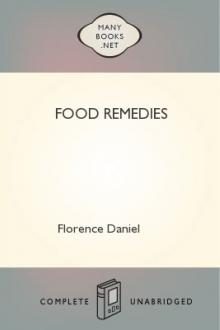The Chemistry of Food and Nutrition, A. W. Duncan [i love reading .txt] 📗

- Author: A. W. Duncan
- Performer: -
Book online «The Chemistry of Food and Nutrition, A. W. Duncan [i love reading .txt] 📗». Author A. W. Duncan
For infants the only satisfactory food is that of a healthy mother. On account of physical defects in the mother, or often for merely selfish reasons, the infant is deprived of its natural food. Many attempts have been made to bring cow's milk to approximately the same composition as human milk. It can be done by adding water, milk sugar and cream of known composition, in certain proportions. Great difficulties are met with when this is put into practice. The simplest method is that of Professor Soxhlet. The proper quantity of milk sugar is added, but instead of adding the right quantity of cream or fat—a very difficult thing to do—the equivalent quantity of extra milk sugar is used. Although not theoretically satisfactory, in practice it answers very well. We have found it to agree very well with infants. To cow's milk of pure average quality, add half its volume of water containing 12.3 per cent. of milk sugar; or, what amounts to the same thing, to a pint of cow's milk add one and a quarter ounce of milk sugar and half-a-pint of water. It is preferable to Pasteurise by placing the bottle of milk in a vessel of water. This water is to be heated until the milk shows a temperature of about 75° C. or 165° F., but must not exceed 80° C. or a change in the albumen of the milk takes place which affects its digestibility. Keep at this temperature for about ten minutes. If not required at once, a plug of cotton wool should be placed in the neck of the bottle, and it should be kept in a cold place until required. Professor Soxhlet does not advise the addition of lime water. The proteids are not of the same composition as in human milk (the calf being a ruminating animal)—and it is a common plan to add water or barley water to milk until it is so watered down that it cannot curdle into tough curds. An infant has thus either to distend its stomach with a large quantity of watery nourishment, or else to get insufficient food. Sometimes it is necessary to peptonise the milk a little. At the Leipzig infants hospital, and also the Hygienic Institute, they give to infants, up to 9 months old, Prof. Soxhlet's mixture, except that an equal volume of water is added to the milk. Milk, cheese, and especially hen's eggs contain a very large proportion of proteid. When added to food poor in proteid they improve its nutritive quality. It has often been said, and with truth, that some vegetarians by the profuse use of animal products, consume as much, or even more proteid of animal origin than the average person who includes flesh food in his dietary. An excess of proteid from these sources is less injurious as eggs contain no purins, and milk but a very small quantity. In support of the use of animal products, it may be said that we have become so fond of animal foods and stimulating drinks, that the use of milk, butter, cheese and eggs renders the transition to a dietary derived from the vegetable kingdom much easier. By means of these, cooked dishes can be produced which approach and sometimes can scarcely be distinguished from those of cooked flesh.
In the present state of society, when really good vegetarian fare is difficult to procure away from home, eggs, cheese, and milk are a great convenience.
Digestion.—The digestive juices contain certain unorganised ferments, which produce chemical changes in the food. If the food is solid, it has to be liquefied. Even if already liquid it has generally to undergo a chemical change before being fitted for absorption into the body. The alimentary canal is a tubular passage which is first expanded into the mouth, and later into the stomach. As the food passes down, it is acted upon by several digestive juices, and in the small intestine the nutritive matter is absorbed, whilst the residue passes away.
The saliva is the first digestive juice. It is alkaline and contains a ferment called ptyalin. This acts energetically on the cooked and gelatinous starch, and slowly on the raw starch. Starch is quite insoluble in water, but the first product of salivary digestion is a less complex substance called soluble-starch. When time is allowed for the action to be completed, the starch is converted into one of the sugars called maltose. In infants this property of acting on starch does not appear in effective degree until the sixth or seventh month, and starch should not be given before that time. Only a small quantity should be provided before the twelfth month, when it may be gradually increased. Dr. Sims Wallace has suggested that the eruption of the lower incisors from the seventh to the eighth month, was for the purpose of enabling the infant—in the pre-cooking stage of man's existence—to pierce the outer covering of fruits so as to permit his extracting the soluble contents by suction; and accordingly when these teeth are cut we may allow the child to bite at such vegetable substances as apples, oranges, and sugar cane. Dr. Harry Campbell says that starch should be given to the young, "not as is the custom, as liquid or pap, but in a form compelling vigorous mastication, for it is certain that early man, from the time he emerged from the ape till he discovered how to cook his vegetable food, obtained practically all his starch in such a form. If it is given as liquid or pap it will pass down as starch into the stomach, to setup disturbance in that organ; while if it is administered in a form which obliges the child to chew it properly, not only will the jaws, the teeth, and the gums obtain the exercise which they crave, and without which they cannot develop normally, but the starch will be thoroughly insalivated that much of it will be converted within the mouth into maltose. Hard well baked crusts constitute a convenient form in which to administer starch to children. A piece of crust may be put in the oven and rebaked, and spread with butter. Later, we may give hard plain biscuits." Dr. Campbell continues, that he does not say that starch in the pappy form, or as porridge, should find no place whatever in man's dietary at the present day, but we should arrange that a large proportion of our food is in a form inviting mastication.
The teeth perform the very important function of breaking down our food and enabling it to be intimately incorporated with the saliva and afterwards with the digestive juices. The Anglo-Saxon race shows a greater tendency to degeneracy in the teeth than do other races; the teeth of the present generation are less perfect than those of previous generations. A dentist writes (Lancet, 1903-2, p. 1054) "I have had the opportunity of examining the teeth of many natives in their more or less uncivilised state, from the Red Indians of North America, the negroes of Africa, to the more civilised Chinese, Japanese, and Indians of the East, and I have usually found them possessed of sound teeth, but so soon as they come under the influence of civilised life in Washington, Montreal, London, Paris and other cities, their teeth begin to degenerate, though their general health may remain good." In a long article on mastication in the Lancet (1903-2, p. 84) from which we have already quoted, Dr. Harry Campbell gives as the effect of thorough and efficient mastication, that it increases the amount of alkaline saliva passing into the stomach, and prolongs the period of starch digestion within that organ. That it influences the stomach reflexly by promoting the flow of gastric juice. That the frequent use of the jaws and the tongue, during the period of growth, cause the jaws to expand. If the jaws are not adequately exercised during this period, owing to the use of soft food, they do not reach their normal size, the teeth are overcrowded, do not develop fully, and are prone to decay. The effect of vigorous mastication is to stimulate the circulation in the tooth pulp, which promotes nutrition and maintains a firm dental setting. Dr. Campbell writes: "I am perfectly at one with Dr. Wallace, in believing that the removal of the fibrous portion of food is the main cause of the prevalence of caries among moderns."
When the food reaches the stomach, gastric juice is secreted. This juice contains a ferment called pepsin and hydrochloric acid. Pepsin is only active in an acid media. Starch digestion proceeds in the stomach to such a time—stated as from 15 to 30 minutes—when the acid gastric juice has been poured out in sufficient quantity to neutralise the alkalinity of the saliva. The gastric juice acts upon the proteids only. After a time the liquefied contents of the stomach are passed into the first portion of the small intestine, called the duodenum. Here it meets with the pancreatic juice, which like the gastric juice attacks proteids, but even more energetically, and only in an alkaline media. The proteolitic ferment is called trypsin. The pancreatic, the most important of the digestive fluids, contains other ferments; one called amylopsin, takes up the digestion of any remaining or imperfectly converted starch left from the salivary digestion. Amylopsin is much more powerful and rapid than the ptyalin of the saliva, especially on uncooked starch. Its absence from the pancreatic juice of infants is an indication that starch should not be given them. Another ferment, stearopsin, emulsifies fats. The bile





Comments (0)